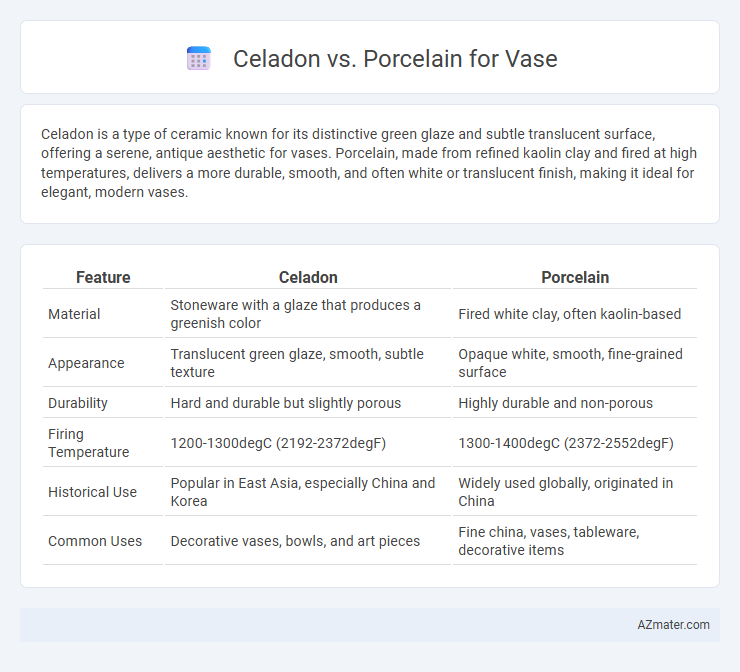Celadon is a type of ceramic known for its distinctive green glaze and subtle translucent surface, offering a serene, antique aesthetic for vases. Porcelain, made from refined kaolin clay and fired at high temperatures, delivers a more durable, smooth, and often white or translucent finish, making it ideal for elegant, modern vases.
Table of Comparison
| Feature | Celadon | Porcelain |
|---|---|---|
| Material | Stoneware with a glaze that produces a greenish color | Fired white clay, often kaolin-based |
| Appearance | Translucent green glaze, smooth, subtle texture | Opaque white, smooth, fine-grained surface |
| Durability | Hard and durable but slightly porous | Highly durable and non-porous |
| Firing Temperature | 1200-1300degC (2192-2372degF) | 1300-1400degC (2372-2552degF) |
| Historical Use | Popular in East Asia, especially China and Korea | Widely used globally, originated in China |
| Common Uses | Decorative vases, bowls, and art pieces | Fine china, vases, tableware, decorative items |
Introduction to Celadon and Porcelain Vases
Celadon vases are renowned for their distinctive jade-green glaze, created through a high-temperature firing process involving iron oxide that results in a translucent, smooth finish revered in East Asian ceramics. Porcelain vases, characterized by their white, fine-grained, and highly durable ceramic body, are fired at even higher temperatures, producing a non-porous surface that allows for intricate designs and a glossy sheen. Both materials hold significant cultural and artistic value, with celadon prized for its subtle color variations and porcelain admired for its strength and versatility in decorative art.
Historical Origins of Celadon and Porcelain
Celadon originated during the Eastern Han Dynasty in China, around the 2nd century AD, characterized by its distinctive jade-green glaze achieved through iron oxide firing techniques. Porcelain, developed later during the Tang Dynasty and perfected in the Song Dynasty, is a high-fired ceramic made from kaolin clay, known for its white, translucent body and durability. Both materials have rich historical significance in East Asian art, with celadon prized for its subtle glaze hues and porcelain for its refined, delicate craftsmanship.
Material Composition: Celadon vs Porcelain
Celadon vases are crafted from a stoneware clay that contains iron oxide, which creates their signature translucent green glaze through a reduction firing process. Porcelain vases are made from a refined kaolin clay mixed with feldspar and quartz, fired at higher temperatures to achieve a hard, white, and translucent body. The key material difference lies in celadon's iron-based glaze chemistry versus porcelain's purity and vitrification, impacting texture, strength, and color opacity.
Firing Techniques and Glaze Differences
Celadon vases are characterized by their translucent glaze made from iron oxide, which undergoes a reduction firing process at lower temperatures around 1200degC, producing a distinctive green to blue-green hue. Porcelain vases are fired at higher temperatures, typically between 1300degC and 1400degC, in an oxidation atmosphere, resulting in a harder, more durable ceramic body with a white, often glossy glaze. The firing techniques directly influence glaze composition and surface finish: celadon's slow cooling and reduction firing create its signature soft sheen and subtle color variations, while porcelain's high-temperature oxidation firing yields a more uniform and brilliant glaze.
Visual Aesthetics: Color, Texture, and Finish
Celadon vases showcase a distinctive translucent glaze in soft green or blue hues with a smooth, glossy surface that highlights subtle crackle patterns, enhancing their tactile depth. Porcelain vases typically feature a pure white or off-white base with a smooth, often matte or glossy finish, emphasizing fine detailing and sharp contours. The texture of celadon is inherently glassy and cool to the touch, while porcelain boasts a refined, delicate feel with a more polished, opaque appearance.
Durability and Practical Uses
Celadon vases, made from stoneware, exhibit higher durability due to their dense, fired clay composition, making them less prone to chipping or cracking compared to porcelain vases. Porcelain vases, crafted from fine kaolin clay and fired at higher temperatures, offer a translucent, delicate appearance but are more brittle and susceptible to damage with heavy use. For practical uses, celadon vases are ideal for everyday handling and outdoor display, while porcelain vases suit decorative settings that require careful handling to preserve their fragile beauty.
Cultural Significance and Symbolism
Celadon vases, renowned for their jade-like green glaze, symbolize purity, renewal, and harmony in East Asian cultures, particularly Korea and China. Porcelain vases, often featuring intricate blue-and-white patterns, represent elegance, refinement, and longevity, deeply rooted in Chinese imperial art traditions. Both ceramics carry rich symbolic meanings, with celadon evoking natural serenity and porcelain embodying perfection and cultural heritage.
Price and Collectible Value Comparison
Celadon vases typically offer a more affordable price point compared to the often high-cost porcelain counterparts, largely due to differences in production techniques and rarity. Porcelain vases, especially antique or artist-signed pieces, command significant collectible value driven by their durability, translucence, and historical significance. Collectors prioritize porcelain for long-term investment potential, while celadon is favored for aesthetic appeal and budget-friendly acquisitions.
Choosing the Right Vase for Your Space
Celadon vases feature a distinctive jade-green glaze and a smooth, translucent finish that complements minimalist or Asian-inspired interiors, adding a touch of serene elegance. Porcelain vases offer a wide range of colors and intricate designs with a glossy, durable surface, fitting well in classic or contemporary spaces that demand versatility and refinement. When choosing the right vase for your space, consider the color palette, texture, and overall style to ensure the vase enhances your room's aesthetic and functional needs.
Conclusion: Which Vase Material Suits You Best?
Celadon vases offer a unique, translucent glaze with a subtle green hue, ideal for those seeking an antique and artistic aesthetic. Porcelain vases provide a smooth, durable surface with a wide range of colors and designs, perfect for modern or elegant home decor. Choosing between celadon and porcelain depends on your preference for traditional craftsmanship versus versatile, contemporary style.

Infographic: Celadon vs Porcelain for Vase
 azmater.com
azmater.com